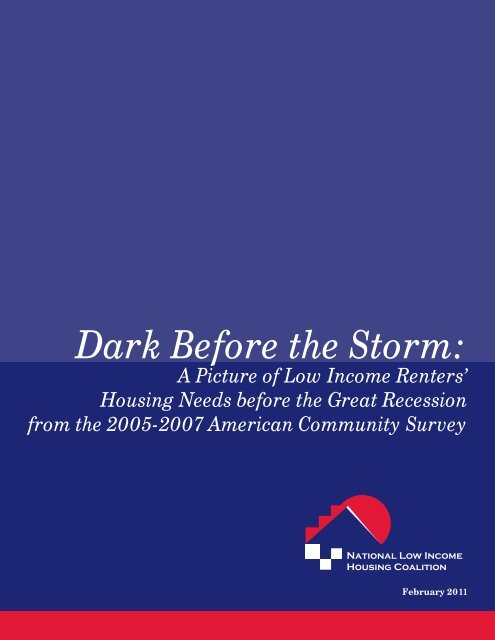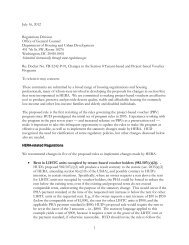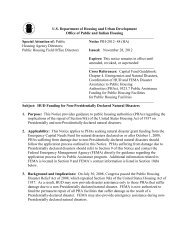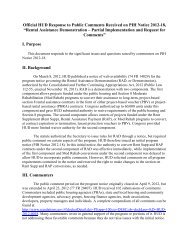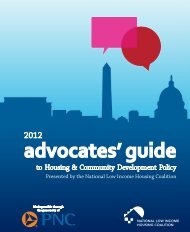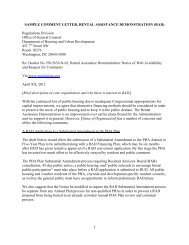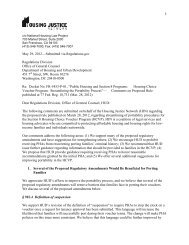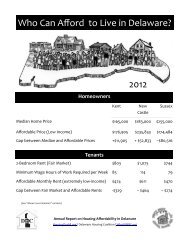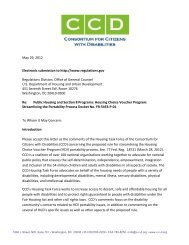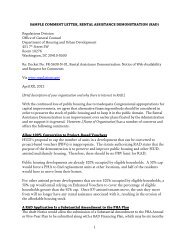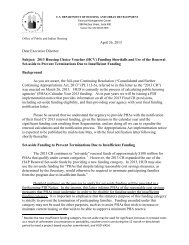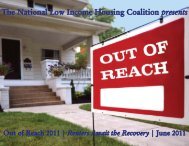Dark Before the Storm (.pdf, 131 KB) - National Low Income Housing ...
Dark Before the Storm (.pdf, 131 KB) - National Low Income Housing ...
Dark Before the Storm (.pdf, 131 KB) - National Low Income Housing ...
You also want an ePaper? Increase the reach of your titles
YUMPU automatically turns print PDFs into web optimized ePapers that Google loves.
<strong>Dark</strong> <strong>Before</strong> <strong>the</strong> <strong>Storm</strong>:<br />
A Picture of <strong>Low</strong> <strong>Income</strong> Renters’<br />
<strong>Housing</strong> Needs before <strong>the</strong> Great Recession<br />
from <strong>the</strong> 2005-2007 American Community Survey<br />
<strong>National</strong> <strong>Low</strong> <strong>Income</strong><br />
<strong>Housing</strong> Coalition<br />
February 2011
NLIHC Board of Directors<br />
Mark Allison, Supportive <strong>Housing</strong> Coalition of New Mexico, Albuquerque, NM<br />
Nancy Bernstine, <strong>National</strong> AIDS <strong>Housing</strong> Coalition, Washington, DC<br />
Mary Brooks, Center for Community Change, Frazier Park, CA<br />
Gail Burks, Nevada Fair <strong>Housing</strong> Center, Las Vegas, NV<br />
Maria Cabildo, East Los Angeles Community Corporation, Los Angeles, CA<br />
Delorise Calhoun, Cincinnati <strong>Housing</strong> Authority, Cincinnati, OH<br />
Dede Carney, Carney & Company Team, Greenville, NC<br />
Donald Chamberlain, Sound Thinking, Seattle, WA<br />
Brenda Clement, <strong>Housing</strong> Action Coalition, Pawtucket, RI<br />
Marcie Cohen, AFL-CIO <strong>Housing</strong> Investment Trust, Washington, DC<br />
Charles Elsesser, Jr., Florida Legal Services, Miami, FL<br />
Bill Faith, Coalition on <strong>Housing</strong> and Homelessness in Ohio, Columbus, OH<br />
Matt Gerard, Minneapolis Highrise Representative Council, Minneapolis, MN<br />
Lisa Hasegawa, <strong>National</strong> Coalition for Asian Pacific American Community Development, Washington, DC<br />
Linda Leaks, Grassroots Empowerment Project, Washington, DC<br />
Moises Loza, <strong>Housing</strong> Assistance Council, Washington, DC<br />
George Moses, <strong>Housing</strong> Alliance of Pennsylvania, Pittsburgh, PA<br />
Reymundo Ocañas, BBVA Compass, Houston, TX<br />
Greg Payne, Maine Affordable <strong>Housing</strong> Coalition, Portland, ME<br />
Diane Randall, The Partnership for Strong Communities, Hartford, CT<br />
Tara Rollins, Utah <strong>Housing</strong> Coalition, Salt Lake City, UT<br />
Julie Spezia, <strong>Housing</strong> California, Sacramento, CA<br />
Paul Weech, Stewards of Affordable <strong>Housing</strong> for <strong>the</strong> Future, Washington, DC<br />
Leonard Williams, Buffalo Municipial <strong>Housing</strong> Authority, Buffalo, NY<br />
Established in 1974 by Cushing N. Dolbeare, <strong>the</strong> <strong>National</strong> <strong>Low</strong> <strong>Income</strong> <strong>Housing</strong> Coalition is<br />
dedicated solely to ending America’s affordable housing crisis. NLIHC educates, organizes and<br />
advocates to ensure decent, affordable housing within healthy neighborhoods for everyone.<br />
NLIHC provides up-to-date information, formulates policy, and educates <strong>the</strong> public on housing<br />
needs and <strong>the</strong> strategies for solutions.<br />
Visit us online at www.nlihc.org<br />
The authors would like to thank Kathryn P. Nelson for her invaluable comments and edits<br />
to this report, as well as for her assistance in creating <strong>the</strong> state tables from <strong>the</strong> CHAS data.
<strong>Dark</strong> <strong>Before</strong> <strong>the</strong> <strong>Storm</strong>:<br />
A Picture of <strong>Low</strong> <strong>Income</strong> Renters’<br />
<strong>Housing</strong> Needs before <strong>the</strong> Great<br />
Recession from <strong>the</strong> 2005-2007<br />
American Community Survey<br />
Megan DeCrappeo<br />
Danilo Pelletiere, Ph.D.<br />
<strong>National</strong> <strong>Low</strong> <strong>Income</strong> <strong>Housing</strong> Coalition<br />
February 2011
Executive Summary<br />
This report provides <strong>the</strong> results of an analysis of new U.S. Department of <strong>Housing</strong> and Urban Development (HUD) data that<br />
use <strong>the</strong> 2005-2007 American Community Survey (ACS) to replicate indicators of housing need last released using Census<br />
2000 data. More information on this data, <strong>the</strong> Comprehensive <strong>Housing</strong> Affordability Strategy (CHAS) data, can be found in<br />
Appendix A. The picture of housing need that emerges from this three-year period, which stretches from <strong>the</strong> very peak of <strong>the</strong><br />
housing boom to just before <strong>the</strong> latest recession took hold, is grim. Among <strong>the</strong> key findings of this report:<br />
• Over three-fourths of extremely low income (ELI) and very low income (VLI) renter households in <strong>the</strong> U.S. had at<br />
least one housing problem in 2005-2007. Worse, 63% of ELI renters and 28% of VLI renters paid more than half of<br />
<strong>the</strong>ir income on rent and utilities. Spending more than half of household income on housing is <strong>the</strong> definition of severe<br />
housing cost burden.<br />
• In ten states 65% or more of ELI renter households had severe housing cost burdens. Seven of <strong>the</strong>se states are in <strong>the</strong><br />
West, with <strong>the</strong> highest rates in Nevada (71%), Oregon (69%) and California (69%). South Dakota is <strong>the</strong> only state in <strong>the</strong><br />
country where fewer than half (49%) of <strong>the</strong>se lowest-income renters had severe burdens.<br />
• The U.S. would have needed at least an additional 3,400,000 units of standard 1 rental units that were affordable<br />
to ELI households to make up for <strong>the</strong> shortage of units compared to renters in 2005-2007. Because many of <strong>the</strong> units<br />
affordable to ELI renters were occupied by higher income households, approximately 6,000,000 more standard rental<br />
units that were both affordable and available to ELI renter households were actually needed. Some of <strong>the</strong>se shortfalls of<br />
affordable and available units could be met by additional project and tenant based subsidies for ELI renters.<br />
• Forty-four states and <strong>the</strong> District of Columbia had absolute shortages of housing affordable for ELI renter households,<br />
and every state needed more units that are both affordable and available to ELI renters. Ten of <strong>the</strong> thirteen states in <strong>the</strong><br />
West had fewer than 35 affordable and available units for every 100 ELI renter households, making it <strong>the</strong> most difficult<br />
region for an ELI renter to find an affordable home. There were only three states where <strong>the</strong> number of affordable and<br />
available units per 100 ELI renter households was as high as 1 unit for every 2 renter households.<br />
Comparisons to NLIHC’s earlier analysis of <strong>the</strong> 2000 data reveal that <strong>the</strong> situation in 2005-2007 was far worse than it<br />
had been only 7 years earlier. Considering <strong>the</strong> deep recession that hit <strong>the</strong> U.S. at <strong>the</strong> end of 2007, <strong>the</strong>se findings are also<br />
an indicator of <strong>the</strong> gravity of <strong>the</strong> current situation. As <strong>the</strong> federal government works to reform <strong>the</strong> nation’s housing policy<br />
and markets and increase opportunity for all, it is imperative that <strong>the</strong> lack of truly affordable housing for <strong>the</strong> lowest income<br />
households be addressed in a comprehensive and meaningful way.<br />
To address <strong>the</strong> housing problems outlined in this report, NLIHC makes <strong>the</strong> following policy recommendations:<br />
• Provide funding for <strong>the</strong> <strong>National</strong> <strong>Housing</strong> Trust Fund (NHTF) which was established in 2008. Once funded, <strong>the</strong> NHTF<br />
will allow for <strong>the</strong> production, rehabilitation and preservation of 1,500,000 units of affordable housing over <strong>the</strong> next 10<br />
years, with 75% of this housing targeted to ELI households. This is currently <strong>the</strong> only federal program that is specifically<br />
focused at producing new rental units for <strong>the</strong> ELI population.<br />
• Make improvements to <strong>the</strong> current <strong>Housing</strong> Choice Voucher program by passing <strong>the</strong> Section 8 Voucher Reform Act<br />
(SEVRA) and provide funding for 2,000,000 new vouchers over <strong>the</strong> next 10 years.<br />
• Promote greater equity in federal housing subsidies both along <strong>the</strong> income spectrum and between homeowners and<br />
renters and redirect <strong>the</strong> savings from <strong>the</strong>se efforts to fund NHTF and <strong>Housing</strong> Choice Vouchers.<br />
1 A standard unit has complete kitchen and plumbing facilities.<br />
2
Increased Prevalence of <strong>Housing</strong> Problems Overall for <strong>Low</strong> <strong>Income</strong><br />
Renters<br />
A previous NLIHC report using <strong>the</strong> 1990 and 2000 Comprehensive <strong>Housing</strong> Affordability Strategy (CHAS) data (See<br />
Appendix 1 for more information on CHAS data) found that during <strong>the</strong> 1990s, a decade of strong economic growth, <strong>the</strong><br />
shares of all renter households with housing problems and severe rent burdens fell slightly in each of <strong>the</strong> three low income<br />
groups examined, 2 but this trend did not continue in <strong>the</strong> 2000s. Shares of low income renters with at least one housing<br />
problem - paying too much for <strong>the</strong>ir housing, living in crowded conditions, or lacking standard plumbing and kitchen<br />
facilities (See Box 1 for definitions of key terms) - were higher nationally and in nearly every state in 2005-2007 compared<br />
to <strong>the</strong> 2000 data (See Appendix 2, Table A-1). 3 This meant that even before <strong>the</strong> recession low income Americans had less to<br />
spend on non-housing necessities or were making unacceptable trade-offs to put a roof over <strong>the</strong>ir head.<br />
In <strong>the</strong> 1990s, housing problems became more concentrated among <strong>the</strong> lowest income renter households. In 2005-2007, 77%<br />
of ELI renters faced a housing problem, compared to 74% identified in <strong>the</strong> 2000 data (See Appendix 2, Table A-1). However,<br />
between <strong>the</strong> two surveys, <strong>the</strong>se problems moved up <strong>the</strong> income scale in that VLI renters saw <strong>the</strong> largest increase in <strong>the</strong> share<br />
of households with at least one housing problem. Looking at <strong>the</strong> percentage of households with housing problems in each<br />
Box 1: Definitions<br />
HUD <strong>Income</strong> Definitions Used for Renter Households<br />
Area Median <strong>Income</strong> (AMI) . . . . . . . . . . . . . . . . . . . . . . . . . . . . . . . . . . . . . . . . . . . . . . . . . . . . . .Local area median income<br />
Extremely <strong>Low</strong> <strong>Income</strong> (ELI). . . . . . . . . . . . . . . . . . . . . . . . . . . . . . . . . . . . . . . . . . . . . . . . . . . . . . . . . . . . . . . 0-30% of AMI<br />
Very <strong>Low</strong> <strong>Income</strong> (VLI) . . . . . . . . . . . . . . . . . . . . . . . . . . . . . . . . . . . . . . . . . . . . . . . . . . . . . . . . . . . . . . . . . . 31-50% of AMI<br />
<strong>Low</strong> <strong>Income</strong> (LI) . . . . . . . . . . . . . . . . . . . . . . . . . . . . . . . . . . . . . . . . . . . . . . . . . . . . . . . . . . . . . . . . . . . . . . . . 51-80% of AMI<br />
Not <strong>Low</strong> <strong>Income</strong> . . . . . . . . . . . . . . . . . . . . . . . . . . . . . . . . . . . . . . . . . . . . . . . . . . . . . . . . . . . . . . . Greater than 80% of AMI<br />
Definitions of Cost Burden<br />
Cost Burden: The percent of a household’s income spent on housing.<br />
Unaffordable Cost Burden: Spending over 30% of household income on housing.<br />
Severe Cost Burden: Spending over 50% of household income on housing.<br />
O<strong>the</strong>r Problems: In addition to unaffordable cost burden, <strong>the</strong> CHAS data identify overcrowding (more than one<br />
person per room) and substandard housing (lacking complete kitchen or plumbing facilities).<br />
2 Nelson, Kathryn P., Treskon, Mark. & Pelletiere, Danilo. (2004). Losing Ground in <strong>the</strong> Best of Times: <strong>Low</strong> <strong>Income</strong> Renters in <strong>the</strong> 1990s.<br />
Washington, DC: <strong>National</strong> <strong>Low</strong> <strong>Income</strong> <strong>Housing</strong> Coalition.<br />
3 This report examines national and state data, but it is also possible to observe within state differences by using CHAS county or city data. For<br />
an example, see: Mierzwa, E. & Nelson, K. with Newberger, H. (2010). Affordability and availability of rental housing in Pennsylvania. Philadelphia,<br />
PA: Federal Reserve of Philadelphia.<br />
3
of <strong>the</strong> four regions specified by <strong>the</strong> Census Bureau, we see that in <strong>the</strong> West and in <strong>the</strong> South, VLI renters now have slightly<br />
higher shares of households with at least one housing problem (84% and 76% respectively) than ELI renters (82% and 75%).<br />
In <strong>the</strong> West, this boost appears to result from higher than average rates of overcrowding among VLI households than in<br />
o<strong>the</strong>r parts of <strong>the</strong> country, with states like California and Arizona showing overcrowding rates among VLI households of 19%<br />
and 12% compared to a national rate of 8%. 4<br />
Underlying this rise in <strong>the</strong> percentage of renters with at least one housing problem is increased shares of low income renter<br />
households with unaffordable cost burdens, <strong>the</strong> housing problem affecting <strong>the</strong> greatest number of households (See Appendix<br />
2, Table A-2A). In 2000, 70% of <strong>the</strong> 8,100,000 ELI renter households lived in unaffordable housing. By 2005-2007, 76%<br />
of <strong>the</strong> 9,200,000 ELI renter households had unaffordable housing costs (See Appendix 2, Table A-2B). The number of VLI<br />
renter households with unaffordable cost burdens increased from 3,800,000 (out of a total of 5,900,000) to 4,900,000 (out<br />
of a total of 6,600,000 VLI renter households), or from 64% of VLI renter households to 74%. The largest percentage-point<br />
increase in unaffordable cost burden impacted LI renter households: 29% of <strong>the</strong> 7,600,000 LI households had unaffordable<br />
housing costs in 2000 compared to 40% of <strong>the</strong> 7,900,000 LI households with this housing problem in 2005-2007. However,<br />
not only do LI renters continue to have much lower shares of households with unaffordable cost burden than ELI and VLI<br />
households but ELI households are much more likely to have severe housing cost burdens than ei<strong>the</strong>r VLI or LI renters.<br />
Households that spend over half of <strong>the</strong>ir income on housing and utility costs each month have little remaining for o<strong>the</strong>r<br />
necessities such as child care, transportation, food and health care, especially if <strong>the</strong>ir total income is low enough to qualify<br />
as ELI. Households in this situation have a greater chance of becoming homeless because a one-time emergency can easily<br />
throw <strong>the</strong>m into serious financial trouble. In 2005-2007, 63% of all ELI renter households experienced severe cost burden,<br />
compared to 28% of VLI renter households and just 6% of LI renter households (See Appendix 2, Table A-2A).<br />
There are close to 8,200,000 renters with severe housing cost burdens. ELI renters make up 71% of <strong>the</strong>se severely burdened<br />
households, while only representing 25% of <strong>the</strong> total renter population. Alternatively, households that earn between 51 and<br />
80% of AMI make up 22% of <strong>the</strong> renter population, but only 5% of <strong>the</strong>se renters face <strong>the</strong> problem of severe cost burdens. Thus,<br />
even though <strong>the</strong>re were large increases in shares of LI households with unaffordable cost burden, affordability problems,<br />
especially severe affordability problems, continue to be concentrated among ELI and increasingly VLI renter households.<br />
Regional Variations in <strong>Housing</strong> Problems and Unaffordable<br />
<strong>Housing</strong> Costs<br />
The national trends discussed above were reflected in all 50 states and <strong>the</strong> District of Columbia, but with noticeable regional<br />
variations. As was true in 2000, low income renters in <strong>the</strong> West were particularly vulnerable to housing problems and<br />
unaffordable housing costs in 2005-2007: 82% of ELI households and 84% of VLI households in <strong>the</strong> region had at least one<br />
housing problem, with 67% of ELI renters paying more than half of <strong>the</strong>ir income on housing costs (See Appendix 2, Table<br />
A-1 and Table-2A). Of <strong>the</strong> ten states in which 65% or more of <strong>the</strong> ELI renter households have severe cost burden, seven are in<br />
<strong>the</strong> West, with <strong>the</strong> highest rates in Nevada (71%), Oregon (69%) and California (69%). The Nor<strong>the</strong>ast and <strong>the</strong> South had <strong>the</strong><br />
lowest shares of ELI renter households with severe cost burden, particularly Massachusetts (52%) and West Virginia (52%).<br />
South Dakota, in <strong>the</strong> Midwest, had <strong>the</strong> lowest share of ELI renter households with severe cost burden (49%) nationwide, and<br />
is <strong>the</strong> only state in <strong>the</strong> country where this rate is below 50% (See Appendix 2, Table A-2A).<br />
4 NLIHC tabulations of CHAS 2000 and CHAS 2005-2007 data.<br />
4
While <strong>the</strong> West has <strong>the</strong> highest rates of housing cost burden among ELI renter households in 2005-2007, <strong>the</strong> Midwest<br />
experienced <strong>the</strong> greatest increase in housing cost burden since 2000 (See Appendix 2, Table A-2B ). In 2000 <strong>the</strong> Midwest<br />
had <strong>the</strong> lowest share of ELI households facing severe rent burden at 52%, but in 2005-2007 this share was 62%, making it<br />
<strong>the</strong> region with <strong>the</strong> second greatest proportion of ELI renters with severe rent burden after <strong>the</strong> West. In no state or income<br />
level analyzed did <strong>the</strong> share of renters living in unaffordable housing decrease after 2000. This pattern contrasts sharply<br />
with changes from 1990 to 2000, when ELI renters were only more likely to have severe rent burden in 2000 than in 1990<br />
in eleven states. 5 The West and <strong>the</strong> Nor<strong>the</strong>ast experienced <strong>the</strong> smallest increases in unaffordable housing costs from 2000<br />
to 2005-2007 with an increase of five percentage points for ELI households in both regions.<br />
As was observed nationally, affordability problems at <strong>the</strong> state level worsened for income groups across <strong>the</strong> board, and it<br />
was VLI households specifically that were most likely to see deterioration in housing affordability. In 2000, <strong>the</strong>re were only<br />
three states in which <strong>the</strong> share of VLI renter households with severe cost burden was over 30%, but in <strong>the</strong> 2005-2007 data,<br />
that number is eleven. In <strong>the</strong> South, severe housing cost burdens for VLI renters increased by nine percentage points. The<br />
share of LI renters in <strong>the</strong> South paying more than 30% of <strong>the</strong>ir income towards housing costs was up twelve percentage<br />
points from 2000 to 2005-2007 and <strong>the</strong> share of VLI renters who faced unaffordable housing costs in <strong>the</strong> Midwest was<br />
thirteen percentage points higher than it was in <strong>the</strong> 2000 data. However, it remains rare to find LI households with severe<br />
rent burdens, and <strong>the</strong> increase in <strong>the</strong> share that experienced this level of burden was relatively small (2% nationally).<br />
There Are Not Enough Affordable Rental Homes to Meet Demand<br />
The increase in <strong>the</strong> share of all low income households with housing problems, especially unaffordable housing costs, took<br />
place as <strong>the</strong> country experienced a dramatic housing boom that ended in a drastic bust in 2007 and subsequent nationwide<br />
recession. Even in <strong>the</strong> first half of <strong>the</strong> decade, however, <strong>the</strong> recovery from <strong>the</strong> 2001 recession was uneven and lower income<br />
households saw stagnating or even declining incomes even as unemployment remained low and rents continued to rise. 6<br />
This is <strong>the</strong> primary contributor to increases in rent burden across <strong>the</strong> country. Ano<strong>the</strong>r factor in rising rent burdens may be<br />
that many people moved from renting to owning in this period of low interest rates and relatively easy access to credit. In<br />
<strong>the</strong>se years, homeownership rates increased for every income group except for ELI households. Within each income group<br />
it is <strong>the</strong> higher income households who are more likely to move from <strong>the</strong> rental market into homeownership and generally<br />
lower income, more cost burdened households remain renters.<br />
Along with demand factors, however, <strong>the</strong>re also was a decline in <strong>the</strong> supply of affordable rental housing. During <strong>the</strong><br />
boom, many affordable multi- and single-family rental homes were converted to for-sale properties and relatively few new<br />
affordable rental units were developed to replace <strong>the</strong> lost affordable housing stock, resulting in a net loss of affordable rental<br />
homes. 7 Fur<strong>the</strong>rmore, <strong>the</strong> number of hard rental units receiving some type of federal assistance from HUD decreased by a<br />
little over 200,000 units from 2000 to 2008. 8 Comparing <strong>the</strong> 2000 CHAS to <strong>the</strong> 2005-2007 CHAS confirms <strong>the</strong>se trends,<br />
indicating a worsening relationship between supply and demand for affordable rental housing.<br />
5 Nelson, Kathryn P., Treskon, Mark. & Pelletiere, Danilo. (2004).<br />
6 Joint Center for <strong>Housing</strong> Studies of Harvard University. (2007). The State of <strong>the</strong> Nation’s <strong>Housing</strong> 2007. Washington, DC: Author.<br />
7 For example, an analysis using <strong>the</strong> CINCH Rental Market Dynamics report that is based on longitudinal American <strong>Housing</strong> Survey data found<br />
that from 2001 to 2007 <strong>the</strong> country’s stock of unassisted rental housing affordable to households earning 60% or less of AMI decreased by 6.3% while <strong>the</strong><br />
stock of high-rent housing, or housing affordable to those earning 100% or more of AMI increased by 93%. Collinson, R. & Winter, B. (2010, January).<br />
U.S. rental housing characteristics: supply, vacancy, and affordability. HUD PD&R Working Paper 10-01. Washington, DC: U.S. Department of<br />
<strong>Housing</strong> and Urban Development.<br />
8 NLIHC tabulations of HUD’s “A Picture of Subsidized Households” from 2000 and 2008.<br />
5
Table 1 clearly illustrates this relationship by showing <strong>the</strong> change in <strong>the</strong> number of renters at various income levels as well<br />
as <strong>the</strong> change in <strong>the</strong> number of units affordable to <strong>the</strong> households at those income levels. There were over 1,000,000 more<br />
ELI renter households in 2005-2007 than <strong>the</strong>re were in 2000, an increase of 13%. During <strong>the</strong> same time, <strong>the</strong> inventory<br />
of units affordable to people earning less than 30% of AMI shrunk by over 900,000 units, a 14% decline. The number of<br />
VLI and LI renter households also increased over this time period, but not as drastically, and while <strong>the</strong> number of units<br />
affordable to those earning between 31-50% of AMI decreased, causing a growth in demand and a loss of supply for that<br />
income group, <strong>the</strong> number of units affordable to people earning 51-80% of AMI actually increased by 14%. The growth<br />
in <strong>the</strong> number of units affordable to LI renters outpaced <strong>the</strong> growth in <strong>the</strong> number of <strong>the</strong>se households, implying that<br />
conditions most likely improved for <strong>the</strong>se renters and that <strong>the</strong>re is more than enough housing for this income group.<br />
<strong>Housing</strong> units that are affordable to those earning below 30% of AMI are also affordable to those earning more than 30%<br />
AMI and people earning more than 30% of AMI frequently occupy <strong>the</strong>se units. The CHAS data show <strong>the</strong> total number<br />
of standard rental units that are affordable to households below several different income thresholds. These measures of<br />
<strong>the</strong> supply of affordable housing can be compared to <strong>the</strong> demand for that housing, simply defined as <strong>the</strong> total number of<br />
households with incomes at or below <strong>the</strong> same threshold. Expressed as a ratio, this indicates how many standard rental units<br />
are affordable for every renter household of a particular income level. As a difference, it provides an estimate of <strong>the</strong> surplus<br />
or deficit of affordable units. 9 The fact that few of <strong>the</strong>se units are truly available to lower income renters is discussed below.<br />
In 2005-2007, this indicator suggests that <strong>the</strong>re were surpluses of standard affordable units for renters with incomes<br />
below <strong>the</strong> VLI and LI upper limits, but a severe shortage nationwide of units affordable for ELI renter households (See<br />
Appendix 2, Table A-3). At or below <strong>the</strong> 80% of AMI threshold, <strong>the</strong>re were 141 standard affordable units for every 100<br />
renter households. The surplus of units for households earning at or below 50% of AMI was much smaller, with just 105<br />
units of standard affordable housing for every 100 renter households. The ratio for renter households earning below<br />
30% of AMI, however, was just 63, reflecting a shortage of 37 units for every 100 ELI households. The U.S. would need<br />
to create an additional 3,400,000 units of standard affordable housing to make up for <strong>the</strong> ELI affordable rental housing<br />
deficit.<br />
Direct comparison of <strong>the</strong> supply data in <strong>the</strong> 2000 and 2005-2007 datasets is problematic. Beyond <strong>the</strong> differences inherent<br />
in <strong>the</strong> two surveys, HUD included substandard units in <strong>the</strong> 2000 CHAS tables on <strong>the</strong> affordability of units at <strong>the</strong> various<br />
income thresholds, but <strong>the</strong> 2005-2007 data only included standard units. 10 It is not possible to remove substandard<br />
units from <strong>the</strong> 2000 tables or add <strong>the</strong>m to <strong>the</strong> current tables. However, substandard units made up only 1.3% of <strong>the</strong> total<br />
rental housing stock in 2005-2007, so comparisons between <strong>the</strong> two data sources are likely to accurately describe actual<br />
trends for broad geographic areas. Therefore, it is clear that <strong>the</strong> supply of affordable housing was much smaller relative<br />
to demand in <strong>the</strong> 2005-2007 period than it was even in 2000 (See Appendix 2, Table A-3). In 2005-2007 <strong>the</strong>re were only<br />
63 units affordable to ELI renter households per 100 renter households, a drop of 21 units from <strong>the</strong> ratio of 84 in 2000.<br />
Households with incomes below <strong>the</strong> VLI upper threshold continued to have a surplus of affordable units in 2005-2007<br />
(with a ratio of 105), but this surplus diminished, with 25 fewer units per 100 renters than in 2000. The ratio for renters<br />
with incomes below <strong>the</strong> LI threshold fell by only 12 units, but <strong>the</strong> falling ratios for those below <strong>the</strong> VLI and LI thresholds<br />
primarily reflect <strong>the</strong> dramatic decline in units affordable to ELI renter households, as shown in Table A-3A.<br />
9 This estimate is actually an overestimate because this indicator assumes that all households below a maximum income threshold can afford<br />
units at that threshold, when in reality only households at <strong>the</strong> threshold can afford all <strong>the</strong> units in that category. At lower income levels units tend to<br />
be skewed toward <strong>the</strong> higher end of <strong>the</strong> category while households are more evenly distributed throughout. For instance, a 2007 HUD Worst Case<br />
<strong>Housing</strong> Needs report found (Exhibit 3-1) that at <strong>the</strong> 10% of AMI threshold <strong>the</strong>re were fewer than 20 units of affordable and available housing for<br />
every 100 renters while at <strong>the</strong> 30% of AMI threshold <strong>the</strong> number was 44.<br />
10 In <strong>the</strong> Allocation Formula for <strong>the</strong> <strong>National</strong> <strong>Housing</strong> Trust Fund, HUD will measure <strong>the</strong> housing need by calculating <strong>the</strong> shortage of<br />
affordable and available standard units for ELI and VLI renters in each state.<br />
6
Table 1: Change in Number of Renters and Number of Affordable Units<br />
<strong>Income</strong> Level # of Renters # of Renters Change in # of Renters<br />
(2000) (05-07)<br />
0-30% AMI 8,100,775 9,187,335 13%<br />
31-50% AMI 5,999,520 6,620,435 10%<br />
51-80% AMI 7,610,200 7,894,940 4%<br />
<strong>Income</strong> Level # of Affordable Units # of Standard Change in<br />
(2000) Affordable Units # of Affordable Units*<br />
(05-07)<br />
0-30% AMI 6,770,859 5,832,845 -14%<br />
31-50% AMI 11,427,471 10,816,950 -5%<br />
51-80% AMI 14,748,328 16,746,700 14%<br />
* These estimates should be compared with caution due to differences between <strong>the</strong> two sources of information for <strong>the</strong> 2000 and<br />
2005-2007 CHAS datasets, specifically that in 2000 substandard units were included in <strong>the</strong> data and in 2005-2007, only standard<br />
units were included (See Appendix 1 for more information on comparing <strong>the</strong> data).<br />
Source: Special Tabulation (CHAS) Files, U.S. Census and HUD, 2000 and 2005-2007<br />
State and Regional Variation in <strong>the</strong> Supply of Affordable Units<br />
Relative to Demand<br />
In 2000, 25 states had a surplus of housing units affordable for <strong>the</strong>ir ELI renters, but <strong>the</strong> 2005-2007 data show just six<br />
(Nebraska, North Dakota, South Dakota, West Virginia, Montana and Wyoming) with a surplus of affordable standard units.<br />
These states tend to be rural with smaller or declining populations, leading to less demand for rental housing overall. The<br />
state with <strong>the</strong> lowest number of affordable units per 100 ELI renter households is California with just 41, while <strong>the</strong> state with<br />
<strong>the</strong> highest surplus is Wyoming with 144 units of affordable housing for every 100 ELI renters (See Appendix 2, Table A-3).<br />
The ratios of <strong>the</strong> numbers of standard affordable units per 100 ELI renter households fell in every state between 2000<br />
and 2005-2007. Whe<strong>the</strong>r due to <strong>the</strong> economy or <strong>the</strong> changing data and methods (likely both), declines were biggest in <strong>the</strong><br />
Midwest. <strong>National</strong>ly, <strong>the</strong> decrease was 21 units per 100 ELI renter households, but by state decreases ranged from just five<br />
units per 100 households in California to 47 units per 100 households in Iowa, taking that state from a surplus of affordable<br />
housing to ELI renters to a deficit.<br />
The national numbers show an overall surplus of affordable housing for renters below <strong>the</strong> VLI threshold, but at <strong>the</strong> state<br />
level eleven states had insufficient supplies of affordable standard rental housing relative to demand. Deficits occurred most<br />
often in Western and Nor<strong>the</strong>astern states such as California (57), Nevada (67), New Jersey (81) and New York (87), although<br />
Florida, in <strong>the</strong> South, had one of <strong>the</strong> biggest deficits of housing affordable for VLI households (65).<br />
These regional and state-by-state patterns and trends in <strong>the</strong> supply and demand for housing not surprisingly largely mirror<br />
<strong>the</strong> regional shifts seen earlier in unaffordable housing costs and o<strong>the</strong>r housing problems.<br />
7
Shortages of Affordable Units Available to <strong>Low</strong> <strong>Income</strong> Renter<br />
Households<br />
Understanding <strong>the</strong> supply of affordable housing is just <strong>the</strong> first step to identifying <strong>the</strong> housing that is actually available to<br />
renters. There may be some states where it appears at first glance that <strong>the</strong>re is a sufficient supply of units to meet <strong>the</strong> demand<br />
of all ELI renters in <strong>the</strong> state, but this is not <strong>the</strong> whole story. One problem is that this indicator assumes all households below<br />
a maximum income threshold can afford units at that threshold, when in reality only households at <strong>the</strong> threshold can afford<br />
all <strong>the</strong> units in that category. 11 In addition to <strong>the</strong> problem cited above, this indicator also assumes that all of those units are<br />
actually available to ELI renters. These units may not be located near <strong>the</strong> jobs, services, and transportation ELI renters rely<br />
on or <strong>the</strong>y may have o<strong>the</strong>r barriers to access, including housing size and quality.<br />
The CHAS data do, however, provide information on <strong>the</strong> rent levels of rental homes by <strong>the</strong> incomes of <strong>the</strong>ir current<br />
occupants, providing insight into a more direct barrier to affordable rental units by lower income households, namely that<br />
higher income households often live in units that would o<strong>the</strong>rwise be affordable to lower income households. Controlling<br />
for <strong>the</strong>se units provides estimates of <strong>the</strong> supply of units both affordable and potentially available to households at various<br />
income levels. 12<br />
<strong>National</strong>ly, <strong>the</strong>re were only 35 affordable and available standard units per 100 ELI renter households in 2005-2007. There<br />
was also a shortage of standard units affordable and available to renter households below <strong>the</strong> higher VLI threshold level.<br />
Although <strong>the</strong>re remained a surplus of standard units available and affordable to households below <strong>the</strong> LI threshold, at 101<br />
standard, affordable units per 100 renters, <strong>the</strong> surplus was nominal (See Appendix 2, Table A-4).<br />
Every state needed more units affordable and available to ELI renters, but need continues to vary widely across states.<br />
California and Nevada had <strong>the</strong> worst shortages, with only 22 units per 100 ELI renter households. Ten of <strong>the</strong> thirteen<br />
states in <strong>the</strong> West had fewer than 35 affordable and available units for every 100 ELI renter households, making it <strong>the</strong> most<br />
difficult region for an ELI renter to find an affordable unit. In o<strong>the</strong>r regions, <strong>the</strong> states with <strong>the</strong> largest shortages included<br />
Florida (27), Texas (27), New Jersey (34), Michigan (34) and Illinois (34). There were only three states where <strong>the</strong> number<br />
of affordable and available units per 100 ELI renter households was equal to or more than 50; South Dakota (60), North<br />
Dakota (53) and Wyoming (50). The shortages of rental units also affected renter households with incomes below <strong>the</strong> VLI<br />
and LI limits. At both <strong>the</strong> national and state level, <strong>the</strong>re was a shortage of units that were both affordable and available to<br />
renter households with incomes below <strong>the</strong> VLI threshold.<br />
Finally, while <strong>the</strong>re were more affordable and available units than <strong>the</strong>re were renter households earning below <strong>the</strong> LI level<br />
nationally, <strong>the</strong>re were ten states where this was not <strong>the</strong> case in 2005-2007. As with <strong>the</strong> shortages for renters earning below<br />
<strong>the</strong> ELI threshold, <strong>the</strong> greatest shortages for renters earning below <strong>the</strong> VLI threshold occurred in <strong>the</strong> West, with a regional<br />
ratio of only 49 affordable and available units per every 100 renter households.<br />
It is also possible to view <strong>the</strong> deficit or surplus of standard units affordable and available to ELI, VLI and LI renters in each<br />
state (See Appendix 2, Table A-5). The largest numbers of units were needed in states with very large ELI renter populations<br />
11 See Footnote 8.<br />
12 Both of <strong>the</strong>se measures may underestimate housing shortages because of <strong>the</strong> limits of <strong>the</strong> income segments. CHAS data only break down<br />
housing prices and household incomes into a few categories so it is possible that <strong>the</strong> units classified as being affordable to households with incomes<br />
under 30% of <strong>the</strong> AMI are mostly affordable to households closest to <strong>the</strong> 30% level, while a larger number of households have significantly lower<br />
household incomes. A fur<strong>the</strong>r consideration when viewing this data is that <strong>the</strong>se estimates assume that within each state any available unit is available to<br />
any renter, even if <strong>the</strong> renter and <strong>the</strong> unit are in different cities within <strong>the</strong> state.<br />
8
such as California (901,000), New York (563,000), Texas (468,000), Florida (304,000) and Illinois (267,000). All toge<strong>the</strong>r,<br />
<strong>the</strong> United States needs approximately 6,000,000 more standard rental units that are both affordable and available to ELI<br />
renter households.<br />
Though <strong>the</strong> shortage of standard units affordable and available generally decreases when <strong>the</strong> income threshold is raised to<br />
<strong>the</strong> VLI limit, <strong>the</strong>re are fourteen states where this shortage actually increases, indicating that raising <strong>the</strong> income threshold<br />
adds more renters than it does affordable and available units to <strong>the</strong> calculation. Half of <strong>the</strong>se states are in <strong>the</strong> Nor<strong>the</strong>ast,<br />
six are in <strong>the</strong> West and 1 (Florida) is in <strong>the</strong> South. Because many of <strong>the</strong>se states are so populous, <strong>the</strong> national shortage of<br />
units affordable and available to renters with incomes below <strong>the</strong> VLI threshold remains quite high, at 5,400,000. Moving<br />
<strong>the</strong> income threshold up once more to <strong>the</strong> LI level causes declines to <strong>the</strong> shortages in every state, with <strong>the</strong> shortages actually<br />
disappearing in all but ten states.<br />
Shortages of Affordable and Available Units Worsened between<br />
2000 and 2005-2007<br />
Shortages of standard units affordable to ELI renters increased significantly all across <strong>the</strong> country between 2000 and 2005-<br />
2007. The shortage of standard units both affordable and available to ELI renters also increased nationally, but that this<br />
increase was not as significant (See Appendix 2, Table A-3 and Table A-4). However, even though this shortage did not<br />
increase as dramatically as <strong>the</strong> shortage of standard affordable units, it remains a much more severe shortage, especially at<br />
<strong>the</strong> ELI threshold.<br />
States experienced greater and lesser declines in <strong>the</strong> shortage of affordable and available units with <strong>the</strong> caveat that <strong>the</strong> two<br />
datasets are not directly comparable. In two states, California and New York, <strong>the</strong> shortage of affordable and available units<br />
stayed about <strong>the</strong> same from 2000 to 2005-2007, while in all o<strong>the</strong>r states it appears that <strong>the</strong> shortage increased. The states<br />
with <strong>the</strong> biggest differences in <strong>the</strong> number of affordable and available units per 100 ELI renter households were Alabama, a<br />
decline of nineteen units, Kansas, eighteen units, and Georgia, Iowa and Missouri, each lower by seventeen units.<br />
The shortages of affordable and available housing for ELI renters grew <strong>the</strong> most in <strong>the</strong> Midwest and South, but when we<br />
look higher up <strong>the</strong> income distribution at households earning incomes below <strong>the</strong> VLI limit, <strong>the</strong> regions hit <strong>the</strong> hardest are<br />
<strong>the</strong> Nor<strong>the</strong>ast and <strong>the</strong> South with Rhode Island and Alabama losing <strong>the</strong> most affordable and available units per every 100<br />
VLI renter households (25 and 18 respectively) (See Appendix 2, Table A-4). It appears that Alaska is <strong>the</strong> only state where<br />
<strong>the</strong> shortage actually lessened from 2000 to 2005-2007 and in Utah <strong>the</strong> shortage remained <strong>the</strong> same in 2005-2007 as it was<br />
in 2000.<br />
Overall, <strong>the</strong> shortage of units that are both affordable and available to ELI renter households increased from 4,600,000<br />
units in 2000 to 6,000,000 units in 2005-2007. As noted earlier in this report, <strong>the</strong> shortage of units that are affordable<br />
to ELI renters is 3,400,000 in 2005-2007, so an additional 2,600,000 affordable units were occupied by higher-income,<br />
renter households. The time period studied here was right before <strong>the</strong> housing bubble burst and <strong>the</strong> country entered a<br />
serious recession. As more people have lost <strong>the</strong>ir jobs or are earning lower incomes, <strong>the</strong>re has been an increase in <strong>the</strong> need<br />
for affordable rental units. These data show that even before <strong>the</strong> recession <strong>the</strong> supply of affordable units simply was not<br />
sufficient to meet <strong>the</strong> demand.<br />
9
Implications for <strong>Housing</strong> Policy<br />
The overarching message that emerges from this report is that it is becoming more and more difficult for <strong>the</strong> lowest income<br />
households to find affordable housing and that people are spending a greater percentage of <strong>the</strong>ir income on housing costs<br />
than <strong>the</strong>y have in <strong>the</strong> past. It is evident that while more moderate income households (greater than 50% of AMI) may<br />
continue to have a hard time finding housing in some states, overall, it appears that <strong>the</strong> private market has done a good job<br />
of providing affordable housing for this particular group. What <strong>the</strong> report clearly shows is that <strong>the</strong>re exists a real need for<br />
resources that reduce <strong>the</strong> unaffordable cost burden of ELI households.<br />
While we can make broad policy recommendations for programs and legislation that would most certainly improve <strong>the</strong><br />
housing conditions of ELI households across <strong>the</strong> country, we do feel that is important to note that each state has different<br />
needs, and that it is important for local governments to understand <strong>the</strong> particular needs of <strong>the</strong>ir communities before<br />
implementing an affordable housing strategy. CHAS data is available at lower geography levels and <strong>the</strong> data found within this<br />
report can be generated for areas within states to gain a better understanding of <strong>the</strong> unique needs of various communities.<br />
For example, in an area with a declining population and high vacancy rates, housing prices and incomes are likely to be quite<br />
low. In <strong>the</strong>se areas a housing strategy that focuses on providing more housing choice vouchers or improving <strong>the</strong> quality of <strong>the</strong><br />
stock may make more sense than programs focused primarily on building new affordable housing. Alternatively, areas with<br />
job and population growth combined with low vacancy rates and rising rents require an expansion of <strong>the</strong> affordable housing<br />
supply, and programs cannot rely on tenant based vouchers and <strong>the</strong> existing stock. Currently, <strong>the</strong> only federal programs<br />
available for <strong>the</strong> construction of new affordable housing are <strong>Low</strong> <strong>Income</strong> <strong>Housing</strong> Tax Credits (LIHTC) and HOME. These<br />
programs tend to target renters earning 50% of AMI or more unless <strong>the</strong>y have a number of o<strong>the</strong>r subsidies and vouchers<br />
attached to <strong>the</strong>m. As we have seen in this report, this is not <strong>the</strong> population facing <strong>the</strong> most severe housing problems.<br />
A program established in 2008, <strong>the</strong> <strong>National</strong> <strong>Housing</strong> Trust Fund, would provide for <strong>the</strong> production, rehabilitation and<br />
preservation of 1,500,000 units of affordable housing over <strong>the</strong> next 10 years, with 75% of this housing targeted to ELI<br />
households, but it awaits funding.<br />
With all of this in mind, NLIHC makes <strong>the</strong> following policy recommendations:<br />
• Provide funding for <strong>the</strong> <strong>National</strong> <strong>Housing</strong> Trust Fund (NHTF). This is currently <strong>the</strong> only federal program that is<br />
specifically designed to produce new rental units for <strong>the</strong> ELI population.<br />
• Make improvements to <strong>the</strong> current <strong>Housing</strong> Choice Voucher program by passing <strong>the</strong> Section 8 Voucher Reform Act<br />
(SEVRA) and provide funding for 2,000,000 new vouchers over <strong>the</strong> next 10 years.<br />
• Promote greater equity in federal housing subsidies both along <strong>the</strong> income spectrum and between homeowners and<br />
renters and redirect <strong>the</strong> savings from <strong>the</strong>se efforts to fund NHTF and <strong>Housing</strong> Choice Vouchers.<br />
10
Conclusion<br />
This assessment of <strong>the</strong> 2005-07 CHAS data reveals that even before <strong>the</strong> start of <strong>the</strong> housing crisis and <strong>the</strong> current recession,<br />
<strong>the</strong>re were significant shortages of standard rental units that were affordable and available to low income households in<br />
every state and that nationwide, three out of every four ELI and VLI households were spending more than half of <strong>the</strong>ir<br />
income on housing and utility costs.<br />
Since 2007, <strong>the</strong> homeownership rate has fallen due to <strong>the</strong> foreclosure crisis and <strong>the</strong> instability of <strong>the</strong> housing market. 13<br />
Many households are returning to <strong>the</strong> rental market. Fur<strong>the</strong>rmore, <strong>the</strong> unemployment rate has soared and incomes have<br />
declined dramatically. 14 These economic trends suggest that more people have become low income renters and <strong>the</strong> demand<br />
for affordable rental housing will continue to rise. There is, however, no indication that <strong>the</strong> supply of long term affordable<br />
rental housing will meet this rising demand. In fact, in an analysis of <strong>the</strong> 2007 and 2008 American Community Survey<br />
(ACS) data, NLIHC found that <strong>the</strong> affordability gap worsened for <strong>the</strong> lowest income renters in <strong>the</strong>se years 15 and <strong>the</strong> recent<br />
release of <strong>the</strong> 2009 ACS data reveals that <strong>the</strong> proportion of renters facing unaffordable housing costs increased from 2008<br />
to 2009. 16 Fur<strong>the</strong>r data shows that rental vacancy rates are at historic highs, but it does not appear that <strong>the</strong>se vacant units<br />
are affordable to ELI and VLI households. Instead <strong>the</strong>se vacancies are part of high-rent developments that were overbuilt<br />
in <strong>the</strong> boom years and units that were previously for-sale, but are now for-rent. 17 All <strong>the</strong> information presented here shows<br />
worsening housing problems for low income renters from 2000 to 2005-07, and it is very likely that <strong>the</strong> situation has<br />
deteriorated fur<strong>the</strong>r since 2007.<br />
During <strong>the</strong> housing boom of <strong>the</strong> 2000s, <strong>the</strong>re was a rush to build luxury developments to rent and own and in general<br />
a strong emphasis on homeownership in both <strong>the</strong> single family and multifamily sectors, while <strong>the</strong>re was a simultaneous<br />
decrease in <strong>the</strong> supply of units receiving project based assistance from HUD. 18 This report shows that in <strong>the</strong> boom years<br />
<strong>the</strong>se shifts in <strong>the</strong> market and in public policy led to an increase in <strong>the</strong> proportion of renters with one or more housing<br />
problems, especially among VLI and LI renters. The recession has amplified <strong>the</strong>se conditions. While every state has different<br />
needs, broadly defined <strong>the</strong>re is a significant and growing need across <strong>the</strong> country for more affordable housing resources.<br />
13 U.S. Census Bureau. <strong>Housing</strong> vacancies and homeownership (CPS/HVS) second quarter 2009, historic tables, table 8. Washington, DC:<br />
Author.<br />
14 Bureau of Labor Statistics. (2010, October). The employment situation: September 2010. Washington, DC: U.S. Department of Labor.<br />
15 Pelletiere, D. (2009, November). Preliminary assessment of American Community Survey data shows housing affordability gap worsened<br />
for lowest income households from 2007 to 2008. Washington, DC: <strong>National</strong> <strong>Low</strong> <strong>Income</strong> <strong>Housing</strong> Coalition.<br />
16 U.S. Census Bureau. American Community Survey 2008 and 2009, table B25070. Washington, DC: Author.<br />
17 Collinson, R. & Winter, B. (2010, January). U.S. rental housing characteristics: supply, vacancy, and affordability. HUD PD&R Working<br />
Paper 10-01. Washington, DC: U.S. Department of <strong>Housing</strong> and Urban Development.<br />
18 NLIHC tabulations of HUD’s “A Picture of Subsidized Households” from 2000 and 2008.<br />
11
References<br />
Bureau of Labor Statistics. (2010). The employment situation: September 2010. Washington, DC: U.S. Department of Labor.<br />
Collinson, R. & Winter, B. (2010). U.S. rental housing characteristics: supply, vacancy, and affordability. HUD PD&R<br />
Working Paper 10-01. Washington, DC: U.S. Department of <strong>Housing</strong> and Urban Development.<br />
Joint Center for <strong>Housing</strong> Studies of Harvard University. (2007). The State of <strong>the</strong> Nation’s <strong>Housing</strong> 2007. Washington, DC:<br />
Author.<br />
Mierzwa, E. & Nelson, K. with Newberger, H. (2010). Affordability and availability of rental housing in Pennsylvania.<br />
Philadelphia, PA: Federal Reserve Bank of Philadelphia.<br />
Nelson, K. P., Treskon, M. & Pelletiere, D. (2004). Losing ground in <strong>the</strong> best of times: low income renters in <strong>the</strong> 1990s.<br />
Washington, DC: <strong>National</strong> <strong>Low</strong> <strong>Income</strong> <strong>Housing</strong> Coalition.<br />
Pelletiere, D. (2009). Preliminary assessment of American Community Survey data shows housing affordability gap<br />
worsened for lowest income households from 2007 to 2008. Washington, DC: <strong>National</strong> <strong>Low</strong> <strong>Income</strong> <strong>Housing</strong> Coalition.<br />
Richardson, T. & Steffen, B. (2010). The impact of formula allocation discretion in <strong>the</strong> <strong>Housing</strong> Trust Fund. Cityscape,<br />
Volume 12, Number 1. Washington, DC: Office of Policy Development & Research, U.S. Department of <strong>Housing</strong> and Urban<br />
Development,<br />
U.S. Census Bureau. American Community Survey 2008 and 2009, table B25070. Washington, DC: Author.<br />
U.S. Census Bureau. <strong>Housing</strong> vacancies and homeownership (CPS/HVS) second quarter 2009, historic tables, table 8.<br />
Washington, DC: Author.<br />
U.S. Department of <strong>Housing</strong> and Urban Development. American <strong>Housing</strong> Survey, Rental Market Dynamics: 2001-03,<br />
2003-05, 2005-07. Washington, DC: Author.<br />
U.S. Department of <strong>Housing</strong> and Urban Development. A Picture of Subsidized Households 2000 and 2008. Washington,<br />
DC: Author.<br />
U.S. Department of <strong>Housing</strong> and Urban Development and U.S. Census Bureau. Comprehensive <strong>Housing</strong> Affordability<br />
Strategy (CHAS) data. 2000 and 2005-07. Washington, DC: HUD.<br />
U.S. Department of <strong>Housing</strong> and Urban Development. (2007) Worst Case <strong>Housing</strong> Needs 2007: A Report to Congress.<br />
Washington, DC: HUD.<br />
12
Appendix 1: What are <strong>the</strong> CHAS Data?<br />
The Value of CHAS Data<br />
Comprehensive <strong>Housing</strong> Affordability Strategy (CHAS) data are available as special tabulations of <strong>the</strong> 1990 and 2000 Census<br />
and, most recently, of <strong>the</strong> 2005-2007 American Community Survey (ACS). These data are provided to HUD by <strong>the</strong> Census<br />
Bureau and provide users with an opportunity to analyze certain housing needs and housing affordability issues that cannot<br />
be gleaned from <strong>the</strong> standard Census and ACS data publicly provided by <strong>the</strong> Census Bureau. Specifically, <strong>the</strong>se data are<br />
based on HUD-defined income limits. These limits take into account HUD adjustments is determining <strong>the</strong> 30, 50 and 80%<br />
threshold of area median income (AMI)) and are for <strong>the</strong> appropriate HUD defined geography. These data allow planners,<br />
policy makers and researchers to better understand <strong>the</strong> housing needs of low income households identified in terms of<br />
<strong>the</strong> income categories used for HUD programs and research. These data are intended to be used by local governments<br />
throughout <strong>the</strong>ir Consolidated Planning process and HUD has used <strong>the</strong> data in allocation formulas for <strong>the</strong> distribution<br />
of funds to local jurisdictions. One program that is very likely to use CHAS data in its allocation formula is <strong>the</strong> <strong>National</strong><br />
<strong>Housing</strong> Trust Fund (NHTF), which will create and preserve affordable housing for those renters with <strong>the</strong> greatest need<br />
(Richardson, T. & Steffen, B., 2010).<br />
Comparing 2000 CHAS Data to 2005-2007 CHAS Data<br />
The ACS, <strong>the</strong> annual survey that has replaced <strong>the</strong> detailed survey or “long form” of <strong>the</strong> decennial census, was fully<br />
implemented in 2005. This survey allows more frequent updates on critical social, economic and housing data than was<br />
previously possible with <strong>the</strong> decennial census. Yet <strong>the</strong> conversion from <strong>the</strong> “long form” to <strong>the</strong> ACS creates some challenges<br />
for those who want to compare datasets. This is primarily due to <strong>the</strong> fact that <strong>the</strong> sample of households surveyed for <strong>the</strong><br />
ACS is much smaller than those of <strong>the</strong> decennial censuses, making <strong>the</strong> margin of error larger in <strong>the</strong> ACS. To overcome this<br />
problem, <strong>the</strong> Census has combined 3 years of ACS data to create <strong>the</strong> 2005-2007 ACS, providing larger sample sizes that<br />
allow users to examine smaller geographies.<br />
The o<strong>the</strong>r primary reason why CHAS data from <strong>the</strong> ACS are not directly comparable to CHAS data from <strong>the</strong> Census is that<br />
some questions from <strong>the</strong> 2000 survey changed wording or structure when asked in <strong>the</strong> ACS, <strong>the</strong>reby potentially changing <strong>the</strong><br />
understanding of <strong>the</strong> questions and <strong>the</strong> types of answers received. It is especially important to use caution when comparing<br />
<strong>the</strong> housing problems of those earning 51%-80% of AMI, because <strong>the</strong> methodology HUD used in 2005-2007 for determining<br />
80% of AMI differs from that used in 2000. In 2000, if 80% of an area’s median income was greater than <strong>the</strong> US median<br />
income, <strong>the</strong>n it would be capped at <strong>the</strong> US median income, as is done in HUD program implementation, but this adjustment<br />
was not made in <strong>the</strong> 2005-2007 CHAS data. This means that in some areas, it may look like <strong>the</strong>re was a large increase in<br />
<strong>the</strong> number of renters earning 50%-80% of AMI, but this increase may just be due to <strong>the</strong> omission of this adjustment in<br />
<strong>the</strong> data. Even with <strong>the</strong>se issues, it is possible to gain an understanding of <strong>the</strong> types of changes <strong>the</strong> country has seen in <strong>the</strong><br />
housing needs of low income renters in between surveys. In this report we make some comparisons between <strong>the</strong> 2000 and<br />
2005-2007 surveys, but we do so with <strong>the</strong> caveat that <strong>the</strong>se comparisons are to be used with caution.<br />
13
Appendix 2: Data Tables<br />
Table A-1<br />
2005-07 Percentage of <strong>Low</strong> <strong>Income</strong> Renter<br />
Households with Any <strong>Housing</strong> Problems<br />
2000 to 2005-07 Percentage Point Change in Percent<br />
of Renter Households with Any <strong>Housing</strong> Problem*<br />
STATE 0-30% AMI 31-50% AMI 51-80% AMI 0-30% AMI 31-50% AMI 51-80% AMI<br />
Connecticut 75% 73% 39% 4% 8% 9%<br />
Maine 69% 67% 38% 2% 6% 13%<br />
Massachusetts 70% 73% 47% 4% 8% 11%<br />
New Hampshire 72% 76% 46% 2% 9% 17%<br />
New Jersey 78% 82% 49% 4% 6% 4%<br />
New York 80% 78% 51% 3% 3% 2%<br />
Pennsylvania 75% 69% 32% 4% 6% 5%<br />
Rhode Island 68% 73% 41% 2% 15% 19%<br />
Vermont 74% 70% 42% 1% 4% 11%<br />
Nor<strong>the</strong>ast 76% 75% 45% 3% 5% 6%<br />
Illinois 78% 77% 40% 4% 11% 8%<br />
Indiana 78% 73% 32% 6% 11% 8%<br />
Iowa 79% 64% 21% 9% 8% 3%<br />
Kansas 79% 68% 30% 6% 10% 5%<br />
Michigan 78% 73% 35% 4% 12% 10%<br />
Minnesota 76% 68% 28% 5% 7% 4%<br />
Missouri 77% 70% 31% 5% 11% 8%<br />
Nebraska 77% 65% 25% 5% 8% 3%<br />
North Dakota 76% 55% 17% 8% 5% 2%<br />
Ohio 75% 73% 32% 4% 11% 10%<br />
South Dakota 68% 58% 22% 4% 5% 1%<br />
Wisconsin 79% 72% 28% 5% 11% 6%<br />
Midwest 77% 72% 32% 5% 10% 7%<br />
Alabama 70% 63% 33% 5% 7% 6%<br />
Arkansas 75% 70% 38% 7% 7% 6%<br />
Delaware 76% 75% 48% 5% 6% 16%<br />
District of<br />
Columbia 74% 63% 36% 4% 6% 6%<br />
Florida 78% 86% 68% 3% 5% 12%<br />
Georgia 76% 78% 45% 5% 9% 5%<br />
Kentucky 71% 65% 28% 5% 8% 6%<br />
Louisiana 73% 70% 42% 3% 4% 6%<br />
Maryland 76% 77% 38% 3% 9% 7%<br />
Mississippi 70% 72% 44% 3% 10% 8%<br />
North Carolina 75% 74% 40% 5% 8% 7%<br />
Oklahoma 74% 71% 36% 5% 7% 7%<br />
South Carolina 70% 70% 38% 2% 9% 7%<br />
Tennessee 71% 72% 38% 4% 7% 6%<br />
Texas 79% 81% 47% 3% 6% 4%<br />
Virginia 75% 76% 43% 3% 6% 8%<br />
West Virginia 67% 57% 29% 2% 0% 6%<br />
South 75% 76% 46% 4% 7% 7%<br />
Alaska 84% 73% 46% -1% 3% 7%<br />
Arizona 80% 84% 55% 2% 2% 3%<br />
California 83% 87% 65% 1% 0% -2%<br />
Colorado 80% 78% 40% 3% 2% 2%<br />
Hawaii 72% 80% 65% -1% 7% 11%<br />
Idaho 78% 72% 36% 4% 3% 1%<br />
Montana 74% 64% 31% 3% 1% 0%<br />
Nevada 81% 88% 63% 3% 3% 5%<br />
New Mexico 76% 75% 47% 2% 2% 0%<br />
Oregon 80% 83% 46% 2% 3% 2%<br />
Utah 80% 77% 34% 2% 4% -2%<br />
Washington 81% 79% 41% 3% 1% 0%<br />
Wyoming 74% 54% 18% 2% 1% -1%<br />
West 82% 84% 56% 2% 1% 0%<br />
U.S. total 77% 77% 45% 4% 6% 5%<br />
* These estimates should be used with caution due to differences between <strong>the</strong> two sources of information for <strong>the</strong> 2000 and<br />
2005-2007 CHAS datasets (See Appendix 1 for more information on comparing <strong>the</strong> data).<br />
Source: Special Tabulation (CHAS) Files, U.S. Census and HUD, 2000 and 2005-2007<br />
14
Appendix 2: Data Tables<br />
2005-07 Percentage of <strong>Low</strong> <strong>Income</strong> Renter Households with <strong>Housing</strong> Cost Burden<br />
Table A-2A<br />
0-30% AMI 31-50% AMI 51-80% AMI<br />
STATE Burden Severe Burden Burden Severe Burden Burden Severe Burden<br />
Connecticut 74% 59% 70% 21% 34% 3%<br />
Maine 67% 53% 66% 23% 35% 3%<br />
Massachusetts 69% 52% 71% 30% 45% 6%<br />
New Hampshire 71% 57% 75% 25% 43% 4%<br />
New Jersey 77% 64% 79% 32% 43% 5%<br />
New York 78% 65% 76% 34% 44% 7%<br />
Pennsylvania 75% 61% 67% 22% 30% 4%<br />
Rhode Island 68% 54% 72% 30% 39% 4%<br />
Vermont 73% 59% 68% 24% 38% 4%<br />
Nor<strong>the</strong>ast 75% 61% 73% 29% 40% 6%<br />
Illinois 77% 63% 74% 25% 35% 5%<br />
Indiana 77% 64% 71% 21% 28% 3%<br />
Iowa 78% 62% 60% 14% 18% 2%<br />
Kansas 78% 61% 66% 17% 26% 3%<br />
Michigan 77% 64% 72% 23% 32% 4%<br />
Minnesota 75% 58% 65% 18% 24% 3%<br />
Missouri 76% 60% 68% 20% 27% 3%<br />
Nebraska 75% 58% 63% 15% 21% 3%<br />
North Dakota 75% 54% 53% 9% 15% 2%<br />
Ohio 74% 62% 72% 22% 29% 3%<br />
South Dakota 66% 49% 54% 15% 18% 2%<br />
Wisconsin 79% 62% 69% 18% 24% 2%<br />
Midwest 76% 62% 69% 21% 28% 3%<br />
Alabama 69% 54% 61% 21% 29% 3%<br />
Arkansas 73% 60% 67% 22% 32% 4%<br />
Delaware 76% 65% 75% 27% 44% 4%<br />
District of Columbia 72% 54% 58% 15% 31% 5%<br />
Florida 77% 67% 85% 49% 63% 12%<br />
Georgia 75% 64% 76% 30% 41% 4%<br />
Kentucky 70% 55% 63% 17% 24% 2%<br />
Louisiana 70% 58% 68% 28% 37% 5%<br />
Maryland 75% 61% 75% 23% 35% 3%<br />
Mississippi 68% 55% 69% 29% 38% 5%<br />
North Carolina 73% 61% 71% 26% 36% 3%<br />
Oklahoma 73% 61% 68% 21% 31% 3%<br />
South Carolina 68% 57% 68% 24% 35% 4%<br />
Tennessee 69% 57% 70% 25% 34% 3%<br />
Texas 77% 64% 76% 27% 40% 4%<br />
Virginia 73% 62% 75% 26% 40% 4%<br />
West Virginia 66% 52% 56% 16% 27% 2%<br />
South 73% 61% 74% 29% 41% 5%<br />
Alaska 78% 64% 64% 20% 33% 2%<br />
Arizona 77% 67% 79% 33% 48% 8%<br />
California 81% 69% 81% 37% 53% 10%<br />
Colorado 79% 65% 74% 25% 37% 4%<br />
Hawaii 68% 57% 74% 41% 54% 17%<br />
Idaho 76% 61% 68% 20% 31% 3%<br />
Montana 72% 58% 61% 18% 27% 3%<br />
Nevada 79% 71% 85% 42% 57% 8%<br />
New Mexico 75% 62% 72% 24% 40% 5%<br />
Oregon 79% 69% 80% 31% 40% 6%<br />
Utah 79% 65% 73% 19% 28% 3%<br />
Washington 79% 66% 76% 26% 36% 4%<br />
Wyoming 72% 53% 51% 13% 15% 2%<br />
West 80% 67% 79% 33% 47% 8%<br />
U.S. total 76% 63% 74% 28% 40% 6%<br />
Source: Special Tabulation (CHAS) Files, U.S. Census and HUD, 2005-2007<br />
15
Appendix 2: Data Tables<br />
2000 to 2005-07 Percentage Point Change in Percent of Renter Households with <strong>Housing</strong><br />
Cost Burden*<br />
Table A-2B<br />
0-30% AMI 31-50% AMI 51-80% AMI<br />
STATE Burden Severe Burden Burden Severe Burden Burden Severe Burden<br />
Connecticut 5% 6% 10% 7% 11% 1%<br />
Maine 2% 2% 6% 7% 13% 1%<br />
Massachusetts 5% 5% 12% 11% 15% 2%<br />
New Hampshire 2% 4% 11% 8% 19% 2%<br />
New Jersey 6% 7% 10% 11% 9% 1%<br />
New York 5% 4% 6% 8% 9% 2%<br />
Pennsylvania 6% 7% 7% 5% 7% 1%<br />
Rhode Island 3% 8% 19% 18% 22% 2%<br />
Vermont 2% 4% 4% 4% 11% 2%<br />
Nor<strong>the</strong>ast 5% 5% 8% 8% 10% 2%<br />
Illinois 6% 9% 16% 10% 14% 2%<br />
Indiana 7% 11% 13% 8% 10% 1%<br />
Iowa 10% 12% 9% 4% 4% 0%<br />
Kansas 7% 8% 12% 4% 8% 1%<br />
Michigan 5% 10% 15% 10% 14% 2%<br />
Minnesota 7% 10% 10% 6% 7% 1%<br />
Missouri 6% 9% 13% 7% 10% 1%<br />
Nebraska 6% 8% 10% 4% 5% 1%<br />
North Dakota 11% 8% 6% 0% 4% 1%<br />
Ohio 5% 9% 13% 8% 11% 1%<br />
South Dakota 6% 7% 7% 4% 4% 0%<br />
Wisconsin 6% 9% 13% 6% 8% 1%<br />
Midwest 6% 9% 13% 8% 10% 1%<br />
Alabama 7% 8% 9% 7% 8% 1%<br />
Arkansas 8% 9% 9% 5% 9% 1%<br />
Delaware 7% 12% 10% 8% 18% 2%<br />
District of Columbia 8% 8% 15% 7% 13% 2%<br />
Florida 6% 7% 8% 15% 18% 5%<br />
Georgia 7% 11% 13% 11% 12% 1%<br />
Kentucky 6% 8% 10% 6% 8% 0%<br />
Louisiana 5% 6% 7% 8% 11% 2%<br />
Maryland 5% 7% 14% 10% 11% 2%<br />
Mississippi 5% 7% 14% 11% 12% 2%<br />
North Carolina 7% 8% 10% 7% 10% 1%<br />
Oklahoma 6% 8% 8% 6% 11% 1%<br />
South Carolina 3% 7% 11% 7% 10% 1%<br />
Tennessee 5% 7% 9% 8% 8% 0%<br />
Texas 7% 9% 13% 9% 13% 2%<br />
Virginia 5% 7% 10% 8% 11% 1%<br />
West Virginia 4% 4% 2% 1% 7% 0%<br />
South 6% 8% 11% 9% 12% 2%<br />
Alaska 2% 3% 4% 5% 9% 0%<br />
Arizona 5% 8% 8% 7% 11% 3%<br />
California 5% 5% 6% 7% 10% 3%<br />
Colorado 4% 6% 5% 5% 7% 1%<br />
Hawaii 2% 3% 13% 18% 19% 13%<br />
Idaho 5% 4% 7% 2% 6% 1%<br />
Montana 4% 5% 4% 2% 3% 1%<br />
Nevada 6% 8% 6% 11% 13% 4%<br />
New Mexico 5% 5% 7% 2% 5% 0%<br />
Oregon 3% 5% 5% 5% 6% 1%<br />
Utah 4% 4% 7% 3% 5% 1%<br />
Washington 4% 6% 5% 4% 4% 1%<br />
Wyoming 3% 3% 2% 4% 2% 1%<br />
West 5% 5% 6% 7% 9% 3%<br />
U.S. total 6% 7% 10% 8% 11% 2%<br />
* These estimates should be compared with caution due to differences between <strong>the</strong> two sources of<br />
information for <strong>the</strong> 2000 and 2005-2007 CHAS datasets (See Appendix 1 for more information on<br />
comparing <strong>the</strong> data).<br />
Source: Special Tabulation (CHAS) Files, U.S. Census and HUD, 2000 and 2005-2007<br />
16
Appendix 2: Data Tables<br />
2000 to 2005-07 Change in (Standard)<br />
Table A-3<br />
Standard Affordable Units per 100<br />
Renter Households<br />
Affordable Units per 100 Renter<br />
Households*<br />
STATE 0-30AMI 0-50AMI 0-80AMI 0-30AMI 0-50AMI 0-80AMI<br />
Connecticut 66 108 138 -15 -31 -14<br />
Maine 92 110 144 -14 -42 -14<br />
Massachusetts 71 96 <strong>131</strong> -16 -32 -14<br />
New Hampshire 69 99 146 -18 -52 -15<br />
New Jersey 53 81 137 -12 -26 -15<br />
New York 57 87 126 -6 -12 -13<br />
Pennsylvania 75 129 145 -20 -24 -12<br />
Rhode Island 69 99 139 -19 -51 -1<br />
Vermont 80 105 137 -16 -36 -15<br />
Nor<strong>the</strong>ast 63 98 134 -12 -21 -13<br />
Illinois 57 107 143 -27 -41 -10<br />
Indiana 66 139 153 -37 -34 -10<br />
Iowa 89 165 147 -47 -34 -13<br />
Kansas 84 153 153 -44 -37 -15<br />
Michigan 59 119 144 -33 -42 -13<br />
Minnesota 69 134 137 -35 -24 -10<br />
Missouri 75 139 150 -40 -41 -13<br />
Nebraska 101 167 153 -42 -35 -13<br />
North Dakota 123 187 150 -44 -28 -15<br />
Ohio 63 135 149 -33 -37 -12<br />
South Dakota 130 171 150 -36 -27 -10<br />
Wisconsin 65 146 146 -36 -40 -14<br />
Midwest 67 133 147 -34 -37 -12<br />
Alabama 92 132 149 -30 -29 -15<br />
Arkansas 88 128 153 -35 -36 -16<br />
Delaware 71 107 155 -26 -42 -12<br />
District of Columbia 71 112 123 -13 -27 -15<br />
Florida 54 65 128 -11 -27 -19<br />
Georgia 67 110 157 -32 -26 -6<br />
Kentucky 88 146 152 -31 -27 -10<br />
Louisiana 81 110 144 -15 -24 -16<br />
Maryland 69 117 145 -18 -31 -15<br />
Mississippi 90 116 148 -29 -33 -15<br />
North Carolina 75 126 155 -35 -32 -14<br />
Oklahoma 82 139 158 -32 -30 -12<br />
South Carolina 90 133 158 -31 -30 -11<br />
Tennessee 81 125 154 -25 -26 -11<br />
Texas 54 101 153 -24 -27 -12<br />
Virginia 75 118 152 -21 -26 -11<br />
West Virginia 102 134 146 -21 -22 -12<br />
South 71 110 148 -24 -28 -13<br />
Alaska 90 115 150 -46 -40 -21<br />
Arizona 53 87 149 -16 -14 -8<br />
California 41 57 118 -5 -11 -10<br />
Colorado 51 117 146 -21 -9 -4<br />
Hawaii 88 87 115 -24 -26 -31<br />
Idaho 86 138 153 -31 -15 -7<br />
Montana 100 150 150 -33 -14 -9<br />
Nevada 45 67 148 -9 -17 -17<br />
New Mexico 77 115 151 -26 -18 -15<br />
Oregon 47 96 142 -17 -15 -16<br />
Utah 66 134 153 -22 -8 -3<br />
Washington 52 108 144 -15 -10 -12<br />
Wyoming 144 212 161 -20 -6 -7<br />
West 49 79 <strong>131</strong> -12 -11 -10<br />
United States 63 105 141 -21 -25 -12<br />
* These estimates should be compared with caution due to differences between <strong>the</strong> two sources of<br />
information for <strong>the</strong> 2000 and 2005-2007 CHAS datasets, specifically that in 2000 substandard units were<br />
included in <strong>the</strong> data and in 2005-2007, only standard units were included (See Appendix 1 for more<br />
information on comparing <strong>the</strong> data).<br />
Source: Special Tabulation (CHAS) Files, U.S. Census and HUD, 2000 and 2005-2007<br />
17
Appendix 2: Data Tables<br />
Standard Affordable & Available<br />
Units per 100 Renter Households,<br />
2005-07<br />
2000 to 2005-07 Change in<br />
(Standard) Affordable & Available<br />
Units per 100 Renter Households*<br />
Table A-4<br />
STATE 0-30AMI 0-50AMI 0-80AMI 0-30AMI 0-50AMI 0-80AMI<br />
Connecticut 43 71 103 -3 -12 -1<br />
Maine 47 70 104 -6 -17 -5<br />
Massachusetts 49 66 96 -2 -10 -1<br />
New Hampshire 41 60 101 -2 -16 -1<br />
New Jersey 34 54 98 -3 -10 0<br />
New York 35 56 91 0 -5 -3<br />
Pennsylvania 41 79 105 -9 -8 -3<br />
Rhode Island 48 66 103 -7 -25 -2<br />
Vermont 41 64 100 -2 -11 -3<br />
Nor<strong>the</strong>ast 39 63 97 -3 -8 -2<br />
Illinois 34 68 105 -12 -17 -1<br />
Indiana 36 85 111 -14 -9 -1<br />
Iowa 39 89 106 -17 -9 -3<br />
Kansas 39 86 108 -18 -13 -4<br />
Michigan 34 78 108 -14 -13 0<br />
Minnesota 40 84 105 -11 -2 2<br />
Missouri 40 83 108 -17 -16 -5<br />
Nebraska 49 92 108 -9 -6 -4<br />
North Dakota 53 100 107 -16 -6 -6<br />
Ohio 38 86 110 -14 -10 -1<br />
South Dakota 60 92 106 -11 -9 -4<br />
Wisconsin 35 83 106 -12 -9 -2<br />
Midwest 37 81 108 -14 -11 -1<br />
Alabama 48 83 108 -19 -18 -9<br />
Arkansas 43 78 107 -14 -15 -6<br />
Delaware 35 69 107 -14 -14 -3<br />
District of Columbia 49 81 99 -6 -10 -3<br />
Florida 27 41 90 -4 -14 -7<br />
Georgia 36 70 111 -17 -11 2<br />
Kentucky 47 89 110 -12 -9 -2<br />
Louisiana 39 69 101 -11 -15 -8<br />
Maryland 41 73 105 -6 -10 0<br />
Mississippi 43 71 104 -14 -17 -7<br />
North Carolina 39 77 108 -14 -9 -3<br />
Oklahoma 39 83 110 -13 -12 -5<br />
South Carolina 44 80 110 -16 -14 -5<br />
Tennessee 44 78 109 -12 -11 -3<br />
Texas 27 65 108 -11 -9 -1<br />
Virginia 39 68 103 -7 -9 0<br />
West Virginia 47 82 106 -9 -11 -6<br />
South 37 69 105 -11 -12 -3<br />
Alaska 31 61 99 -8 -17 -11<br />
Arizona 24 53 101 -6 -5 -4<br />
California 22 38 85 0 -4 -1<br />
Colorado 29 75 107 -7 6 5<br />
Hawaii 37 47 78 -1 -14 -23<br />
Idaho 33 74 104 -12 -8 -5<br />
Montana 41 82 103 -12 -7 -6<br />
Nevada 22 40 98 -4 -9 -8<br />
New Mexico 34 68 104 -9 -12 -9<br />
Oregon 23 57 98 -7 -6 -7<br />
Utah 30 73 105 -4 0 -1<br />
Washington 28 65 100 -4 -2 -3<br />
Wyoming 50 93 104 -13 -16 -11<br />
West 25 49 92 -3 -4 -2<br />
United States 35 66 101 -8 -9 -2<br />
* These estimates should be used with caution due to differences between <strong>the</strong> two sources of information<br />
for <strong>the</strong> 2000 and 2005-2007 CHAS datasets, specifically that in 2000 substandard units were included in<br />
<strong>the</strong> data and in 2005-2007, only standard units were included (See Appendix 1 for more information on<br />
comparing <strong>the</strong> data).<br />
Source: Special Tabulation (CHAS) Files, U.S. Census and HUD, 2000 and 2005-2007<br />
18
Appendix 2: Data Tables<br />
Table A-5<br />
Shortage (or Surplus) of Standard<br />
Affordable Units, 2005-07<br />
Shortage (or Surplus) of Standard<br />
Affordable & Available Units, 2005-07<br />
State 0-30AMI 0-50AMI 0-80AMI 0-30AMI 0-50AMI 0-80AMI<br />
Connecticut (41,030) 16,030 107,865 (68,745) (56,560) 9,735<br />
Maine (2,780) 7,210 44,350 (19,710) (20,715) 3,630<br />
Massachusetts (79,080) (18,105) 179,095 (138,785) (140,300) (21,055)<br />
New Hampshire (10,055) (335) 39,905 (19,010) (22,115) 1,095<br />
New Jersey (128,930) (85,970) 245,630 (179,710) (205,050) (12,615)<br />
New York (372,875) (173,070) 517,820 (562,955) (608,775) (179,695)<br />
Pennsylvania (92,860) 184,890 421,840 (222,870) (135,620) 43,595<br />
Rhode Island (13,965) (860) 39,385 (23,850) (24,195) 2,580<br />
Vermont (3,640) 1,465 18,035 (10,550) (11,490) 20<br />
Nor<strong>the</strong>ast (745,215) (68,745) 1,613,925 (1,246,185) (1,224,820) (152,710)<br />
Illinois (174,995) 48,120 412,580 (267,495) (209,050) 44,815<br />
Indiana (62,055) 120,595 248,885 (115,710) (47,255) 52,670<br />
Iowa (8,870) 97,750 106,455 (51,030) (15,990) 14,270<br />
Kansas (12,575) 72,715 115,475 (46,530) (19,960) 16,850<br />
Michigan (120,590) 92,065 302,120 (195,545) (108,120) 57,190<br />
Minnesota (45,895) 83,785 136,190 (88,045) (40,600) 19,720<br />
Missouri (43,740) 120,715 230,995 (104,795) (51,790) 36,325<br />
Nebraska 415 62,860 78,820 (26,235) (7,335) 11,635<br />
North Dakota 5,245 36,205 31,260 (10,790) (10) 4,075<br />
Ohio (144,790) 228,235 463,305 (242,575) (92,455) 97,095<br />
South Dakota 7,280 31,270 32,855 (9,655) (3,495) 3,850<br />
Wisconsin (58,455) 138,325 212,980 (110,835) (51,110) 25,720<br />
Midwest (659,025) 1,132,640 2,371,920 (1,269,240) (647,170) 384,215<br />
Alabama (12,255) 80,410 171,410 (78,200) (41,840) 26,600<br />
Arkansas (10,040) 43,360 122,850 (49,115) (34,465) 16,310<br />
Delaware (5,640) 2,310 29,345 (12,610) (10,700) 3,580<br />
District of Columbia (14,660) 8,825 23,775 (25,610) (14,235) (995)<br />
Florida (193,285) (268,810) 344,235 (304,130) (452,950) (120,820)<br />
Georgia (85,000) 47,345 399,015 (164,605) (135,540) 75,660<br />
Kentucky (16,250) 105,730 173,635 (73,330) (24,495) 34,045<br />
Louisiana (27,690) 23,900 146,975 (88,610) (74,565) 4,960<br />
Maryland (48,720) 46,230 192,560 (92,580) (73,915) 21,045<br />
Mississippi (8,445) 22,650 98,155 (48,145) (41,130) 8,095<br />
North Carolina (67,895) 122,060 391,920 (166,555) (109,920) 60,260<br />
Oklahoma (19,185) 73,480 164,755 (64,235) (32,000) 29,030<br />
South Carolina (12,080) 68,865 182,090 (68,355) (41,115) 31,815<br />
Tennessee (34,710) 80,575 255,445 (103,125) (69,440) 41,745<br />
Texas (297,785) 6,510 928,910 (468,255) (401,350) 139,520<br />
Virginia (49,020) 61,905 284,920 (118,840) (109,075) 17,080<br />
West Virginia 1,225 32,080 59,635 (29,140) (16,470) 7,770<br />
South (901,435) 557,425 3,969,630 (1,955,440) (1,683,205) 395,700<br />
Alaska (1,625) 4,615 25,655 (11,615) (12,240) (670)<br />
Arizona (63,735) (33,295) 203,365 (104,135) (120,830) 4,840<br />
California (686,785) (883,050) 571,540 (901,395) (1,287,465) (454,285)<br />
Colorado (73,710) 43,950 180,780 (107,085) (64,545) 27,230<br />
Hawaii (4,090) (7,930) 15,355 (21,465) (31,850) (22,210)<br />
Idaho (4,535) 23,295 52,855 (21,525) (15,845) 3,715<br />
Montana 115 23,815 36,205 (15,990) (8,725) 1,845<br />
Nevada (32,425) (38,405) 96,510 (46,130) (70,045) (4,310)<br />
New Mexico (12,090) 13,605 70,665 (34,135) (28,560) 6,040<br />
Oregon (60,675) (9,040) 139,380 (88,260) (91,050) (6,980)<br />
Utah (15,370) 30,330 77,495 (32,110) (24,300) 6,805<br />
Washington (99,020) 27,625 245,200 (148,920) (125,035) 1,850<br />
Wyoming 5,130 25,190 23,305 (5,845) (1,635) 1,465<br />
West (1,048,815) (779,295) 1,738,310 (1,538,610) (1,882,125) (434,665)<br />
United States (3,354,490) 842,025 9,693,785 (6,009,475) (5,437,320) 192,540<br />
Note: Numbers in paren<strong>the</strong>ses are negative and indicate a deficit of units.<br />
Source: Special Tabulation (CHAS) Files, U.S. Census and HUD, 2005-2007<br />
<br />
19
727 15th Street NW, 6th Floor<br />
Washington, DC 20005<br />
(202)662-1530 (202)393-1973 fax<br />
www.nlihc.org<br />
<strong>National</strong> <strong>Low</strong> <strong>Income</strong> <strong>Housing</strong> Coalition<br />
Membership Form<br />
1. Choose one:<br />
Joining NLIHC<br />
Renewing Membership ( Current Past)<br />
2. Provide your member information (please print):<br />
Mr. Ms. O<strong>the</strong>r:<br />
Name: __________________________________________________<br />
Title: ___________________________________________________<br />
Organization: _____________________________________________<br />
Address: ________________________________________________<br />
_______________________________________________________<br />
City: _____________________________ State: _____ ZIP: ________<br />
Telephone: _________________________ Fax: __________________<br />
Cell: ___________________________________________________<br />
Email: __________________________________________________<br />
Individual members without email may choose to receive Memo by mail:<br />
Organizations may list up to 10 additional people to receive Memo.<br />
Please use space provided on opposite side of page and/or additional sheet.<br />
Let us know who else should be a member. See top of opposite side.<br />
3. Choose a membership type:<br />
Category<br />
Amount (suggested)<br />
Individual with low income, or student $3<br />
Individual $100<br />
Resident Association, low income $10<br />
Organization, $2,000,000 $2000<br />
4. Choose a payment option:<br />
Check (please enclose) Visa Mastercard Exp Date:<br />
Credit card number: ______________________________ CVC*: _____<br />
Cardholder Name (printed): ___________________________________<br />
<br />
Benefits of Membership<br />
Memo to Members<br />
Members receive this much<br />
admired weekly newsletter by email<br />
or mail.<br />
Calls To Action<br />
Members receive email notification<br />
of significant policy developments<br />
requiring constituent calls or letters<br />
to Congress.<br />
Shelterforce Subscription<br />
Discounted Conference Fees<br />
NLIHC hosts an annual policy<br />
conference and leadership<br />
reception in Washington, DC.<br />
The conference draws advocates,<br />
researchers, academics, individuals<br />
with low incomes, and government<br />
experts toge<strong>the</strong>r to provide<br />
expertise and updates on current<br />
federal housing policy initiatives.<br />
Free or Discounted<br />
Publications<br />
NLIHC produces a number of<br />
publications each year, including an<br />
Advocates’ Guide and Out of Reach.<br />
Telephone resource referrals<br />
with linkage to state and<br />
regional networks<br />
Participation in policy-setting<br />
decisions of NLIHC<br />
Dues and gifts are taxexempt under<br />
Section 501(c)(3) of <strong>the</strong> IRS code.<br />
Cardholder Signature: _______________________________________<br />
*Three-digit code on back of card.
<strong>National</strong> <strong>Low</strong> <strong>Income</strong> <strong>Housing</strong> Coalition<br />
727 15th Street N.W., 6th Floor<br />
Washington, DC 20005<br />
(202)662-1530 (202)393-1973 fax<br />
www.nlihc.org


